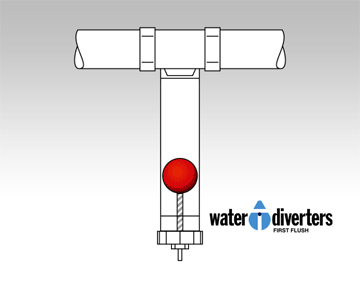Diverters, Pumps, and More!

First Flush Systems
Between downpours, contaminants collect on your roof from the surrounding environment including bird and animal droppings; pollution from vehicles, stoves, and heaters; dust from the atmosphere; and chemicals from roof coatings and sealants. These are all washed down into your tank with the first flow of rainwater. First Flush Water Diverters are a critical component of your rainwater management system. They prevent the first flow of the most contaminated water from reaching your tank thereby improving both the quality and safety of the water. Additionally, this helps to extend the life of pumps and internal appliances such as washing machines or dishwashers and can reduce tank maintenance. The amount of water diverted should be a minimum of 20 litres per 100 square metres of roof area (or 0.2L per m2). In calculating the amount of water to divert, consideration should be given to the surface area of the roof and the amount of pollutants on the roof and in the gutters.

Level Gauges
A very handy device for your tank is a water level gauge. A variety of products are available from simple dipsticks to mechanical float-stick devices and wireless sensors. The choice is yours although it may be dictated by the type of tank you own and its location.

Pumps
It is increasingly popular to pump water from the tank rather than relying on gravitational flow. Manufacturers can supply a range of pumps that are able to meet your needs providing anything from basic flow to supporting a fully automated garden irrigation system. Rainwater pumps should be selected with three things in mind:
Application
Reliability
Noise
It's best to know the pressure and flow rates necessary to run your desired applications before you purchase a pump. For example a shower and lawn sprinkler requires 15 litres per minute (lpm) at 140kPa. However, if you're running an irrigation system, you might need 60lpm at 400kPa. Work backwards from the number of appliances that you want to run at the same time, combine them together, and this will give you the required flow rate. The relevant pressure required is determined by the pipe size used and the length of the pipe. If you stick to 25mm or larger, you won't run into problems around the home and, as a general rule, multistage pumps deliver the highest pressures. A professional will be able to offer sound advice once you have a clear idea of your application.Reliability can be determined by several factors such as the suitability of the pump for its application, the materials of construction, the quality of the installation, water quality, and pump and controller quality.The amount of noise generated by a pump is, of course, dependant on its type. Residential noise, including that of your pump, is governed by EPA guidelines that set prohibited times and maximum noise levels as determined by your proximity to your neighbours.

Leaf Guards
Leaf guards can be fitted to either the full length of your house guttering or as a separate trap (often called a rain head) fitted to any downpipe leading to the tank inlet. Leaves can quickly block downpipes and guards often come as part of the tank package. If one is not already included, you should consider fitting one before you begin capturing rainwater.

Leaf Heads
Also known as rain heads, leaf heads are a simple yet very effective method of preventing leaves and other debris from entering your tank. Most products have two stages of filtration: the first is a larger guage mesh that filters leaves and twigs, redirecting them to the ground. The secondary filter is a smaller, finer mesh that separates dirt and other remaining debris from the water as it flows from the downpipe or gutter outlet, through the leaf head, and into your tank. In most rain heads, the inner mesh also acts as a mosquito filter.

Mosquito Filters
Water tanks can provide the ideal conditions for mosquito breeding and if they can get into your tank, they can contaminate your water supply. You can stop mosquitoes breeding in your water tank by ensuring all entry routes into the tank, including inlet and overflow pipes, are sealed with mosquito filters. These screens should have openings of one millimetre or less, be made of stainless steel or aluminium, and be secure yet easily removed for cleaning. In some systems, mosquito filters can be incorporated (if not already included) in leaf heads, first flush systems, or filter pits.

Filter Pits
In some instances, and where space is limited, leaf heads cannot be fitted under gutters or to downpipes. Filter pits are a great alternative as they allow filtration to occur in a convenient and centralised pit in your garden. For this reason, filter pits are excellent options for use with underground tanks where the tank is placed downhill from your home.

Pump Covers
Pump covers can extend the life of your water pump by protecting it from the elements and may even reduce noise. They are available in a wide range of sizes, colours, and materials to compliment your tank and garden. Artificial rock covers are also available.

%20low%20res.png)